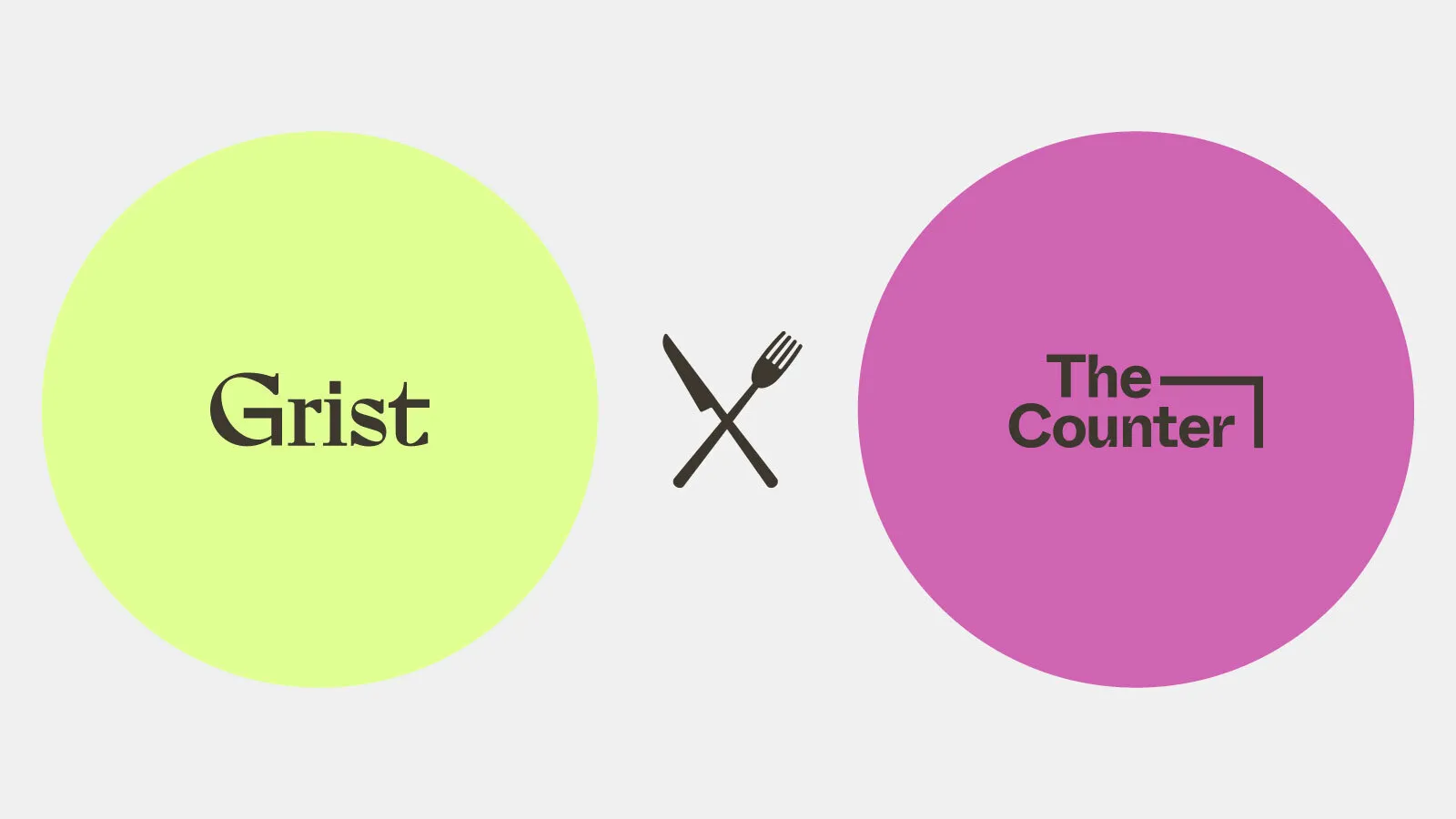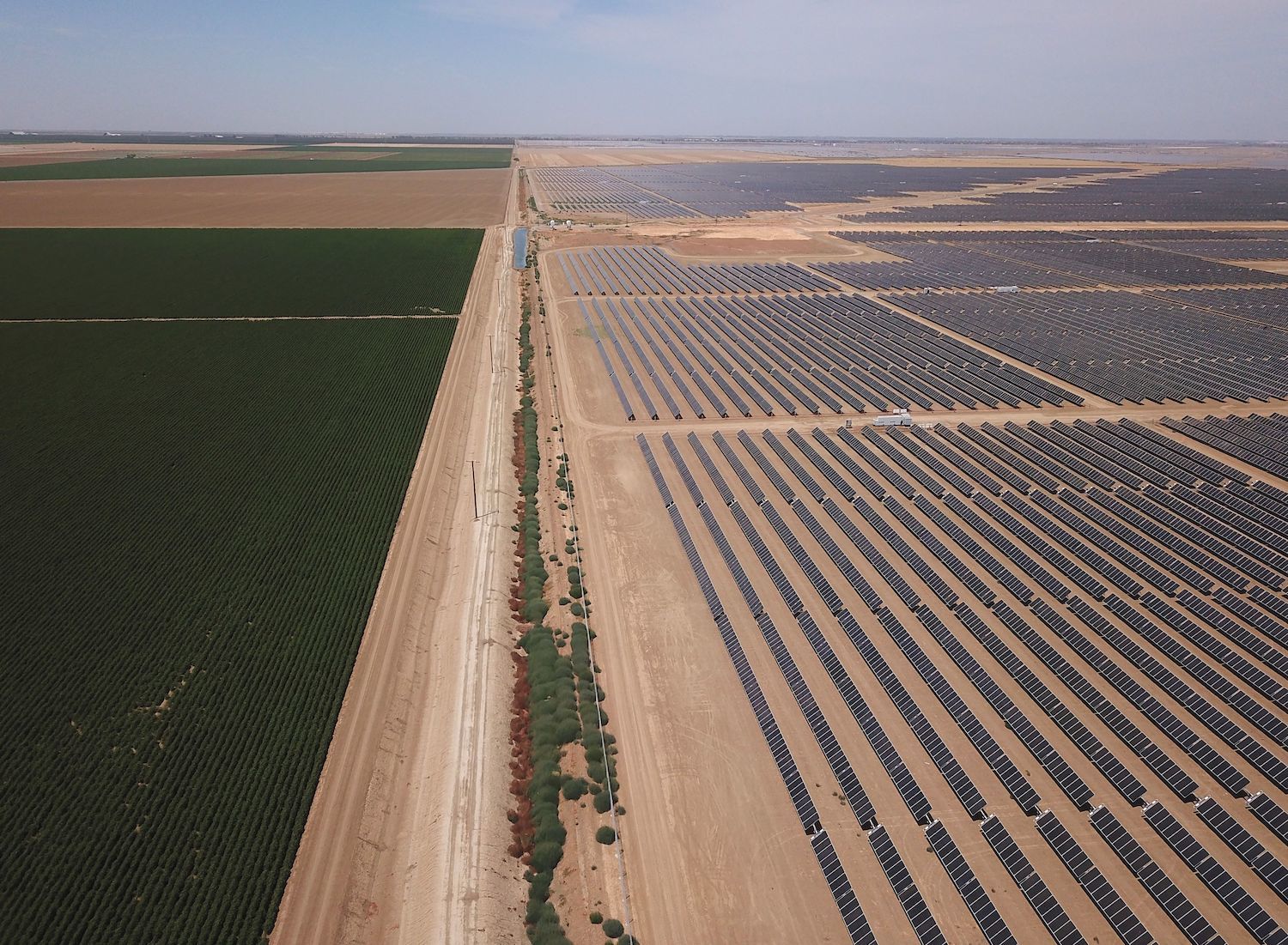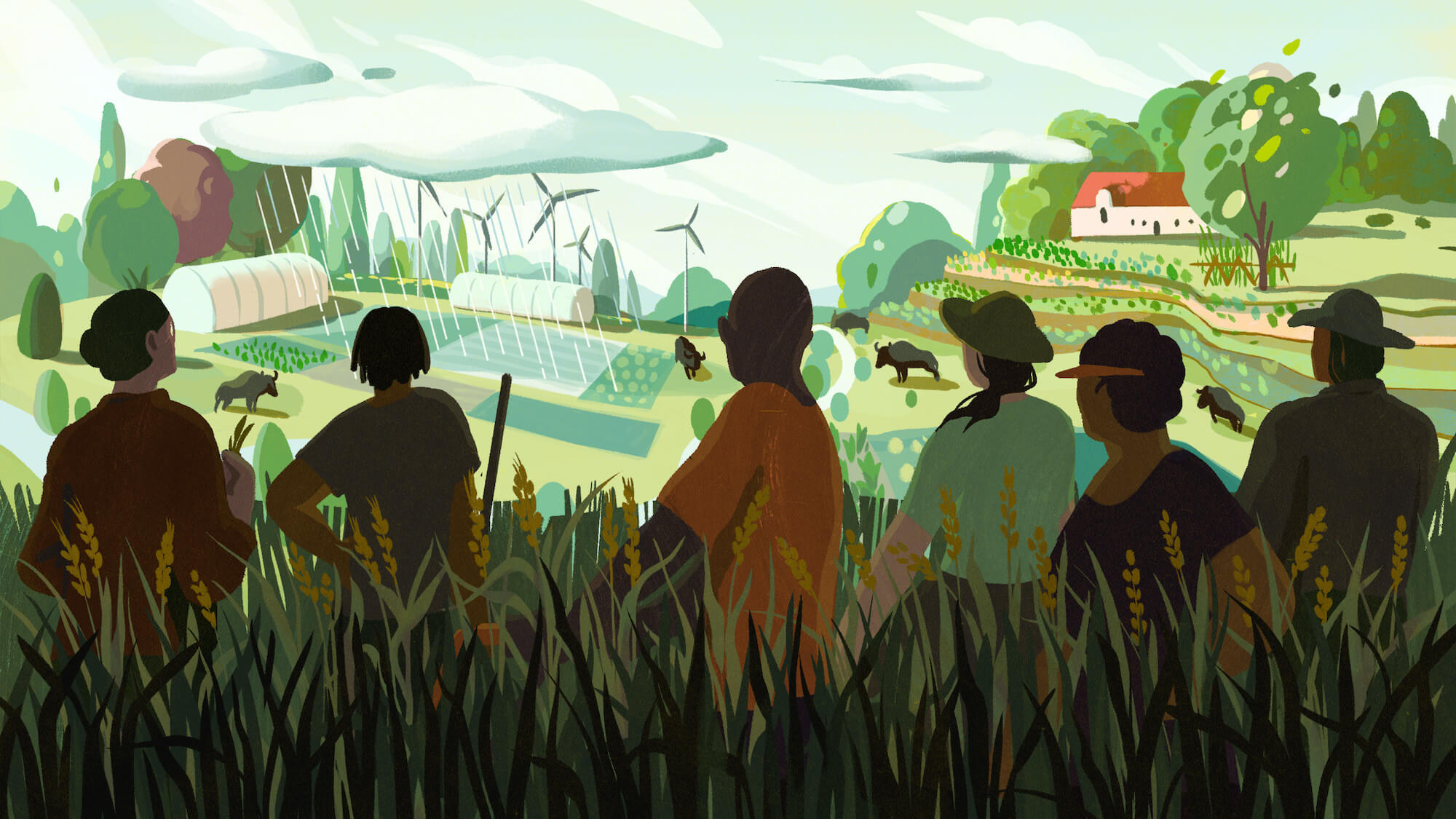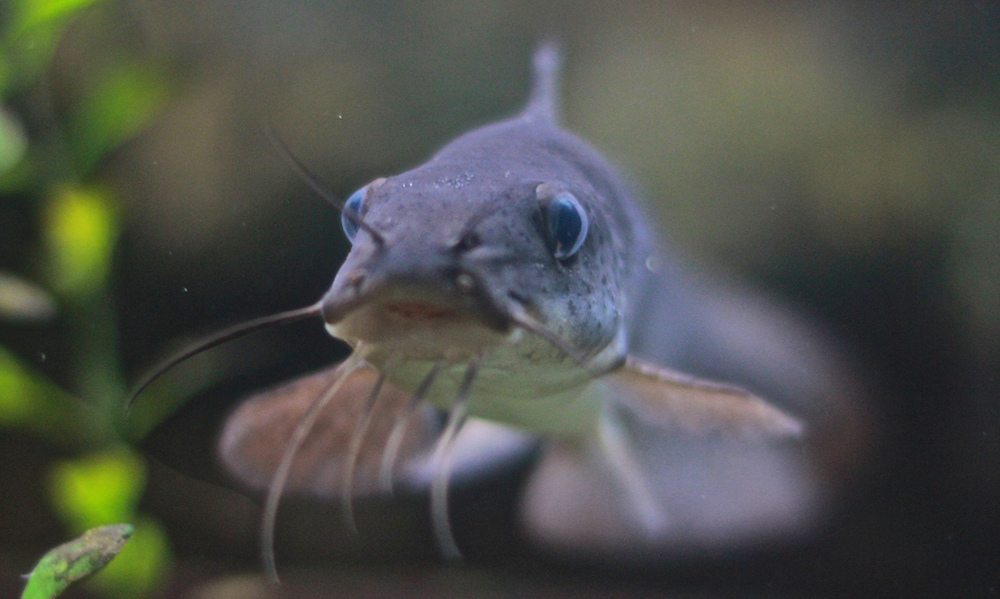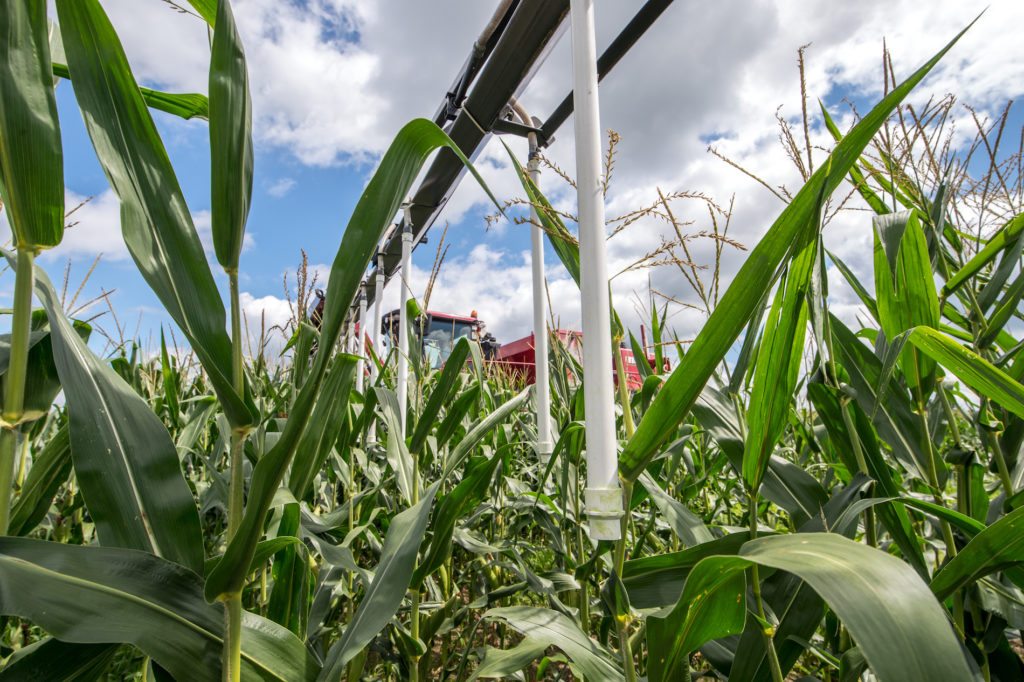
Edwin Remsberg / USDA-SARE
To understand Iowa’s water problem, just follow the Raccoon River as it connects the country to the city, flowing south and east towards Des Moines. For more than a hundred years, Iowa’s state capital has relied on the Raccoon for its drinking water. But before it gets there, the river’s three tributaries first travel through some of the most productive farmland in the United States.
This is Iowa, after all, a state that is 85 percent farmland, punching far outside its weight class in terms of agricultural output. Only the 26th largest state by size, Iowa is the country’s second biggest producer of soybeans and its top producer of corn. Given current practices, it’s inevitable that the chemical inputs applied to nearby crop fields are going to end up in the Raccoon River, headed for Des Moines.
 USDA / Flickr
USDA / Flickr The Raccoon and Des Moines rivers join on the east side of Des Moines, Iowa
In 2015, Stowe told the Des Moines Register that he spent $1.5 million sucking nitrates out of the water at treatment plants outside the city. He estimates that to solve the problem permanently would cost $80 million, and he thinks the nearby counties should shoulder some of the financial burden. But earlier this year, a judge threw out his lawsuit, arguing that the dispute should be resolved by the state legislature, which could regulate farm runoff. That may not happen. Despite clear support among Iowans for improving water quality, the Iowa legislature has dragged its feet on this issue for years.
Still, the specter of regulation, mounting public pressure, and worsening water quality have been enough to get some farmers to agree it’s time to make a change. In fact, there’s already a pretty good solution on the table—one that doesn’t place limits on the amount farmers grow or the volume of fertilizer they use. The trouble is that the remedy requires farmers to plant more, not less, diversifying their fields in a land where corn is king and soybeans are queen.
Air seeder plants cover crops in a cornfield
Matt Liebman, a professor of agronomy at Iowa State university, studies the economic and ecological benefits of more diversified fields. For over a decade, one focus of his research has been comparing the standard corn-soy rotation—where corn is planted one year, then soybeans the next—to longer, more diverse rotations in which small grain crops (like oats) and hay crops (like red clover or alfalfa) are planted between seasons of corn and soybeans.
Liebman’s rotation trial gained national media attention a few years ago when the published results showed both yields and profits were equal or higher for the longer rotations compared to the standard corn-soybean rotation, with a much lower environmental impact. Weed control was similar across all systems, while “freshwater toxicity”—the system’s potential to pollute adjacent water resources—was two orders of magnitude lower with the more diverse rotations.
Case closed, you might think. Farmers all over the Midwest must be running out the door to plant small grains and legumes in between their corn and soybean crops.
But when I reach Liebman by phone in his office in Ames he sounds discouraged—and it’s easy to understand why. In many ways these feel like grim times for natural resource conservation in Iowa. It’s not just the dismissal of the Des Moines Water Works suit. Now a state budget shortfall—linked to low commodity prices—makes funding for environmental measures even less likely. In April, the Iowa House and Senate voted to eliminate all funding for the Leopold Center for Sustainable Agriculture, an internationally renowned research and education effort established at Iowa State in 1987. In short, Liebman summarizes, “We are going to be dealing with water quality issues in Iowa for awhile.”
At the same time, there may be signs of hope. Take an issue central to Liebman’s research: the use of cover crops—usually a small grain or legume, like those used in Liebman’s trial—to cover and protect the soil through the winter. Using cover crops isn’t the same as introducing a longer rotation, but it’s a big step in the right direction, helping to prevent soil erosion and keep nutrients out of waterways. The number of farmers using cover crops in Iowa is small—accounting for just 2.6 percent of corn and soybean acres, according to a newly released study—but it’s increased significantly in the past few years.
 Carlyn Iverson and USDA-SARE
Carlyn Iverson and USDA-SARE Planting cover crops like cereal rye in between seasons helps reduce fertilizer runoff and improve soil health
Now, some influential people—including Iowa Secretary of Agriculture Bill Northey—are looking for ways to make cover crops a standard practice across the Corn Belt, tight budget picture or no. When newly confirmed Ag Secretary Sonny Perdue toured Iowa last week, he held up a “Don’t Farm Naked” shirt for the cameras—a slogan popularized by the Practical Farmers of Iowa to promote cover cropping. It’s a sign that the practice is gaining traction at the highest levels of the federal government.
“We are talking about a potential for 15 to 17 million acres of cover crops in Iowa,” says Ray Gaesser, a farmer in southwest Iowa who is working on the idea with Secretary Northey. Gaesser is what you call a farm leader—a former president of both the Iowa Soybean Association and the American Soybean Association, a winner of Wallaces Farmer magazine’s “Iowa Master Farmer” award. Gaesser and his family grow corn and soybeans on 6,000 acres, and they sowed 3,100 of those acres to cover crops last fall. He estimates that about 10 percent of the farmers in his neighborhood use cover crops, fewer on a big scale like he does. “But interest is definitely growing,” he says. “There are lots of articles, lots of field days at planting and terminating time. It’s building momentum.”
Secretary of Agriculture Sonny Perdue holds up a “Don’t Farm Naked” t-shirt in Nevada, Iowa
For Myers, the uptick in cover crop adoption reflects a new interest in soil health among conventional commodity crop farmers. You can see signs of this browsing conventional farming publications like Successful Farming or Corn and Soybean Digest, which now regularly include articles on cover crop management and other soil health topics. Myers points out that the Commodity Classic, the premier annual gathering for conventional corn, soybean, and cotton growers, has included cover crops among its headline educational themes for the past three years in a row. “Ten years ago they weren’t even talking about them,” he notes.
Despite this momentum, Iowa has only 600,000 acres planted with cover crops today. Will it really be possible to plant 15 million acres every winter across Iowa?
 USDA / Flickr
USDA / Flickr Farm country in northeast Iowa from 10,000 feet
For starters, it helps to know where the 15 million number comes from. A key player in Iowa’s water quality discussion is the Iowa Nutrient Reduction Strategy, a framework document first published in 2012 and updated regularly as new data become available. The INRS was developed by scientists and managers at the Iowa Department of Agriculture and Land Stewardship, the Iowa Department of Natural Resources, and Iowa State University in response to a request from the EPA’s Mississippi River/Gulf of Mexico Watershed Nutrient Task Force, also known as the Hypoxia Task Force. In its 2008 Action Plan, the Task Force asked each of the twelve states along the Mississippi River to outline how they would meet a 45 percent reduction target for nitrogen and phosphorous loss into the Mississippi River watershed.
Meeting the 45 percent reduction target is voluntary, although under the Obama administration there was an assumption that the request could turn into a requirement if it wasn’t taken seriously. With President Trump in office, that assumption has been turned on its head, but Iowa politicians (many of whom are farmers) have always preferred to emphasize voluntary compliance in any case. “If we don’t do something on our own we’re going to be faced with regulations,” Tim Smith, a corn and soybean farmer from Eagle Grove, told Politico last year, in article that highlighted the local preference for self-policing.
You could say that now is an excellent time to test the potential of the voluntary approach.
In Iowa, the vast majority of nutrient loss into waterways comes from agriculture. The INRS had teams of scientists working on the nitrogen question and on the phosphorous question; they assembled tables showing the reductions achievable through the use of different practices—for example, by applying nitrogen fertilizer in the spring instead of in the fall, or by shifting to longer rotations—as well what implementing those various practices would cost. Finally, they came up with a list of eight scenarios showing how the 45 percent reduction could be achieved through different combinations of practices, and what those combinations would cost.
Two scenarios rose to the top as meeting both the nitrogen and phosphorous targets for a relatively reasonable price tag. Both rely heavily on the use of cover crops, in part because cover crops are among the few proposed practices that reduce both nitrogen and phosphorous loss. One scenario proposes 60 percent cover crop adoption, the other 95 percent. With around 23 million acres planted to corn or soybeans in Iowa each year, 15 million acres in cover crops would amount to about a 65 percent adoption rate.
Achieving those numbers would be no mean feat, to be sure. At the farm level, introducing a cover crop into a corn-soybean rotation is challenging because harvest for these crops is so late—October or even running to November—leaving little time to get a cover crop established. Most farmers in Iowa use cereal rye, which germinates well even in cold temperatures. The best method is to drill or broadcast the cover crop seed immediately after combining; some farmers hire a pilot to drop the seed by plane into the standing crop earlier in the year. Killing or incorporating the cover crop in the spring prior to planting also requires management decisions: some farmers use herbicides; others use tillage or crimper-rollers; for those with livestock, the spring cover crop growth can also be used as forage.
 Edwin Remsberg / USDA-SARE
Edwin Remsberg / USDA-SARE In Elizabethtown, PA Jim Hershey of Hershey Farms squats in a cornfield. The spring’s corn crop can be seen emerging through the winter’s cover crop residue
But everyone recognizes that there will never be public money to pay the entire cost of reaching 15 million acres of cover crops in Iowa, much less for funding full implementation of the INRS, estimated at about $4 billion. Acknowledging this reality, a group called the Iowa Agriculture Water Alliance, backed by three of Iowa’s core commodity groups—the Iowa Soybean Association, the Iowa Corn Growers Association, and the Iowa Pork Producers Association—has been focusing on economic development arguments for pursuing the clean-water strategy. Last year, Secretary Northey got behind this effort, announcing a new “Conservation Infrastructure” initiative intended to identify the business opportunities and infrastructure requirements necessary to make the INRS succeed.
Northey recruited Gaesser as his co-chair for the initiative, and Carlson as his cover crop expert. Carlson summarizes their discussions: “We are asking, ‘What are the gaps to scaling conservation in Iowa?’ The first step is to identify those gaps; the second step is to address them. What’s needed to meet the nutrient reduction guidelines? What do we need out there in the landscape?” Taking cover crops as an example, she does the math: “There are about 88,000 farmers in Iowa. Fifteen million acres of cover crops means something like 50,000 farmers planting cover crops.” Among other things, “That means 400,000 acres of [cover crop seed] production. Those are economic opportunities” for farmers, for seed dealers, for co-ops, for equipment manufacturers. Already, a few young farmers have launched businesses providing custom cover crop services.
“We need to get creative,” Carlson emphasizes. “There’s money to made by being green in the winter in Iowa.”
The group’s argument is backed up by research at Iowa State University’s Center for Agricultural and Rural Development, which has estimated that 2,801 direct and indirect full-time jobs would be created by implementing the INRS scenario involving 60 percent cover crop adoption.
 Edwin Remsberg / USDA-SARE
Edwin Remsberg / USDA-SARE A test plot of crimson clover at USDA NRCS Plant Material Center
These kinds of ideas point to a final benefit of making winter cover crops a standard practice in Iowa, which is that they can act as a driver for stimulating adoption of three- or four-crop rotations on at least a portion of Iowa’s corn and soybean land, with the potential to generate additional economic and environmental benefits. Take the case of oats: Iowa used to grow a lot of oats—872,000 acres as recently as 1978, according to USDA data—which is one reason there are still major oat processing facilities in Iowa. Today, those mills process oats grown in Canada or the Ukraine, and when Iowa farmers try to grow oats they sometimes have trouble finding a buyer. Since any of the small grains—rye, barley, oats, triticale—can be grown as cover crops, and since they can all be transformed into a variety of food and feedstuffs for both animals and people, growing lots of cover crops has the potential to stimulate a whole range of market opportunities for agricultural diversification in the Midwest.
Diversification like that might lie far in the future; for the moment, farmers like Ray Gaesser are focused on corn and soybeans. But making corn and soybeans compatible with clean water is starting to sound like an idea most Iowans can get behind.
Correction: An earlier version of this story misstated the year the results of Matt Liebman’s crop rotation trial were published.
